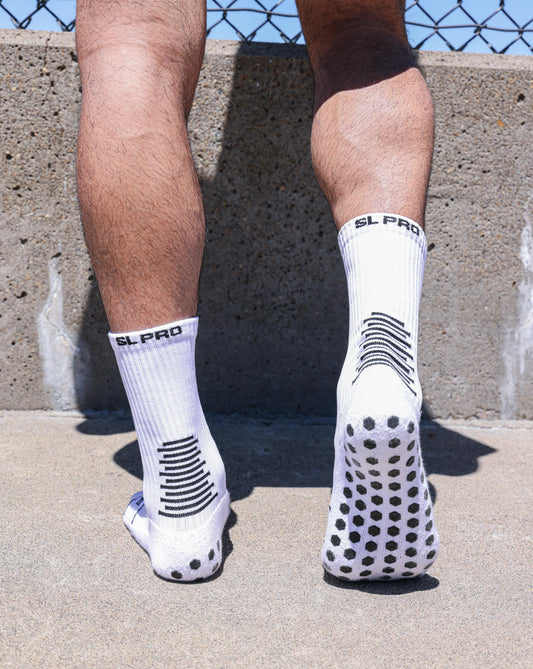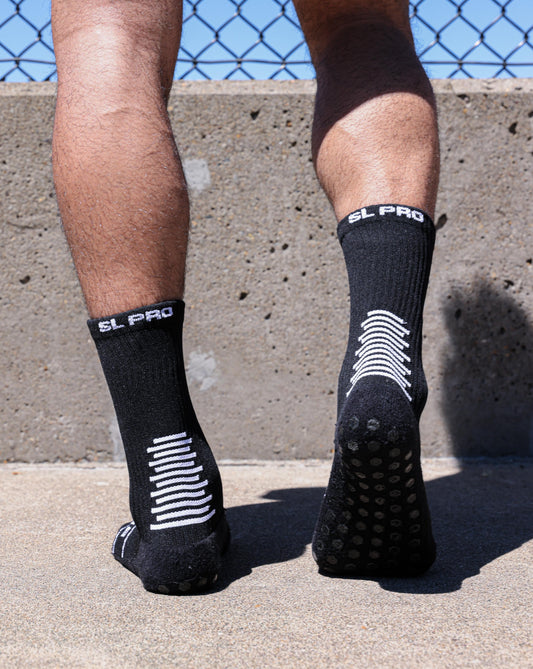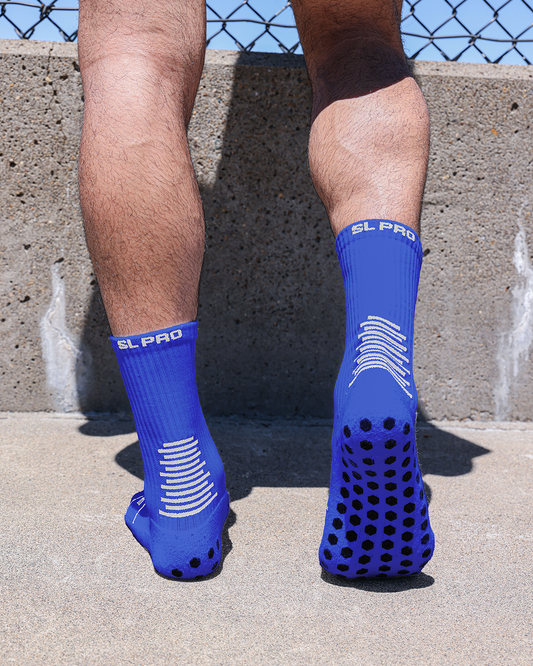Grip Socks vs. Regular Socks: Why Performance Gear Matters
Let’s be honest, when we talk about sports gear, socks are usually an afterthought. We obsess over boots, cleats, shin guards, jerseys… but socks? They’re just socks, right?
Not so fast.
If you’ve ever played a high-intensity match, trained on slick turf, or made that game-saving cut at the last second, you already know: traction, comfort, and support can make or break your performance. And in the world of performance gear, grip socks are quickly becoming the unsung heroes of the pitch.
So what’s the real difference between grip socks vs. regular socks, and does it actually matter?
Let’s dive in.
What Are Grip Socks?
Grip socks are designed specifically to enhance traction inside your shoes. Unlike regular cotton or synthetic athletic socks, grip socks feature rubberized or silicone pads on the bottom and sometimes around the heel. These grips are strategically placed to prevent your foot from sliding inside your boot or cleat, which is a major cause of blisters, instability, and inefficient movement.
They’ve exploded in popularity in soccer, football, rugby, basketball, and even CrossFit for good reason.
The Problem with Regular Socks
We get it, everyone has a drawer full of regular socks. They're cheap, comfortable, and easy to replace. But here’s the deal:
- Regular athletic socks lack grip. This causes your foot to shift inside the shoe, leading to loss of power on cuts and turns.
- They absorb more sweat than performance materials, increasing blisters.
- Most are too thin or too thick, with little consideration for balance, compression, or foot shape.
- Think about it: would you wear regular running shoes on the pitch? Then why wear basic socks in a high-performance environment?
Athlete Insight: What the Pros Say
We reached out to a few athletes to hear how switching to grip socks changed their game.
“Once I started wearing grip socks, I noticed my cuts were sharper. I wasn’t slipping in my cleats anymore. I didn’t realize how much energy I was wasting until I switched.”
- Jake T, Semi-Pro Soccer Player, Oregon
“I used to get heel blisters every other week, especially on turf. Grip socks gave me the lockdown feel I needed, and since then, I haven’t looked back.”
- Sophie L, Collegiate Midfielder
Even Sunday League warriors are noticing the difference. Performance doesn’t belong only to the pros, the right gear levels up everyone.
What the Science Says
It’s not just anecdotal, sports science backs up the benefits of grip socks.
A 2021 study examined grip-enhanced socks in high-movement activities. Researchers found:
- Athletes wearing grip socks showed improved balance and agility scores compared to those wearing regular socks.
- Grip socks significantly reduced in-shoe foot movement, leading to better control.
- Participants reported higher comfort levels and reduced foot fatigue.
- Another 2020 study from a UK university lab tested 40 footballers on turf. Players using grip socks executed directional changes 10-12% faster on average, a major edge in competitive play.
More Than Just Grip: The Hidden Benefits
Let’s not forget, grip socks offer more than just traction:
1. Blister Prevention
Because your foot doesn’t slide around, you dramatically reduce friction-based injuries, a common issue with regular socks.
2. Improved Power Transfer
When your foot stays locked in place, more of your energy goes directly into movement, not wasted on micro-slides inside the shoe.
3. Injury Reduction
Stability means less ankle wobble, fewer rolled ankles, and fewer awkward pivots. While not a substitute for conditioning, grip socks add a layer of joint security.
4. Moisture Control
Most performance grip socks use sweat-wicking materials like nylon blends that keep feet dry and reduce odor. Regular cotton socks? Not so much.
The Cost Question: Are Grip Socks Worth It?
Yes, grip socks usually cost more — a good pair runs anywhere from $20 to $55, compared to a $5 pack of regular socks.
But ask yourself:
- What’s one less blister worth?
- What’s one less ankle tweak or slip in a big game worth?
-
How much would you pay for 10% more control, balance, or speed?
We’re not saying you need grip socks for lounging on the couch. But for training, matches, or serious workouts? They’re a no-brainer.
Real World Example: SL PRO Grip Socks
Let’s talk specifics. Brands like SL PRO have made waves for a reason. Their grip socks come with:
- Multi-directional silicone grip that locks in your foot
- Targeted compression zones for blood flow and support
-
Durable, high-quality materials that last through tough training cycles
And what sets SL PRO apart? For every pair sold, a pair of socks is donated to a community in need. That’s performance with a purpose.
Final Verdict: Grip Socks > Regular Socks (When It Counts)
To wrap it all up, yes, regular socks still have a place. But if you’re serious about performance, injury prevention, and comfort, grip socks are worth every penny.
Just like you wouldn’t wear indoor shoes on turf or jeans to training, you shouldn’t settle for basic socks when your feet are doing the heavy lifting.
Gear matters, and it starts at the ground level.
TL;DR: Grip Socks vs. Regular Socks
|
Feature |
Grip Socks |
Regular Socks |
|
Traction |
✅ Excellent |
❌ Minimal |
|
Blister Protection |
✅ High |
❌ Low |
|
Stability |
✅ Improved |
❌ Lacking |
|
Material |
✅ Moisture-wicking |
❌ Often cotton |
|
Price |
💰 $20–$55 |
💵 $5–$10 |
|
Performance |
✅ Optimized |
❌ Basic |
Want to Try a Pair?
Check out SL PRO Grip Socks and experience the difference for yourself. Whether you’re pushing for playoffs or just playing for pride, your feet deserve better than basic.





